Pro Tour Dragons of Tarkir: By the Numbers
Another Pro Tour weekend has come and gone, and this one was certainly a good one. The field was incredibly diverse, with no one deck making up more than 11 percent of the Day One metagame, a refreshing feat after watching nearly 30 percent of the field play Abzan at Pro Tour Fate Reforged. There was some awesome moments of Magic: Illusory Gains gave the pros headaches in limited all weekend, especially its interaction with Exploit, which caused Top 8 competitor and upside-down-card player Adrian Sullivan to give his opponent a Demonic Tutor with Sidisi, Undead Vizier. We got a look behind the curtain at how the judge call/appeals process works in the "Chapin incident." We also got to see a ton Dragons, highlighted by the "steal your Dragonlord Atarka with Dragonlord Silumgar, kill your Dragonlord Silumgar with my second Dragonlord Atarka, steal your second Dragonlord Atarka with my second Dragonlord Silumgar exchange" in the semis. In short, there was a lot of cool stuff going on at #PTDTK, but awesome plays and interactions are not our topic today. Instead we will be digging into the numbers to see what cards and deck performed well in Brussels and what cards/decks came up short.
Pro Tour Dragons of Tarkir started off with 409 players. After three days of play, which concluded with the dragon-less Mono Red fun police beating a super sweet and dragon-filled U/B Control deck for the $40,000 grand prize, we ended up with 117 decks that managed to go 6-4 or better during the Standard portion of the PT. This amounts to 28.6 percent of all the decks at the tournament. Normally analyzing the results of split-format events like Pro Tours is difficult, but (thankfully) the mothership used a new method of publishing lists which makes it much easier. Instead of just listing all the decks that went 6-4 or better, they actually broke down the lists by the total number of match wins, which allows us to do a more nuanced analysis. If you want to see all the decks in our sample you can find all 117 here. We'll get to the decks momentarily, but first, a couple of important numbers.
Context is everything when it comes to analyzing tournament results by the numbers, so we need to have a baseline or average that we can compare individual decks against. As we move forward, one term you'll hear is conversion rate: this is how many of a deck's day one pilots made day two. Overall, 64 percent of all players made it to day two, making 64 percent the baseline/average. This means a deck that puts more than 64 percent of its players into day two is considered a success, while putting less than 64 percent into day two is a failure. As I mentioned a moment ago, 29 percent of the players at #PTDTK managed to go 6-4 or better in Standard. So again, for a deck, putting less than 29 percent of its players in the 6-4+ bracket is a failure, while putting more than 29 percent in this group is a success. Likewise, 57 players managed to go 7-3 or better in Standard, which makes the baseline here 14 percent, while 23 players (6 percent of the day one field) ended up with a record of 8-2 or better.
One last thing; all the top eight decks are counted in the 8-2+ bracket regardless of their actual Standard record. This is a product of the way the lists were recorded. While this probably isn't ideal, it really doesn't have much of an effect on the data, but I mention it for completeness. Anyway, without further ado, onto the decks.
Red Aggro
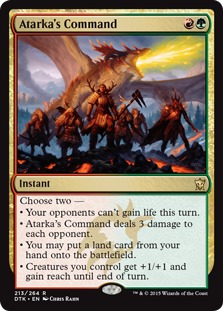

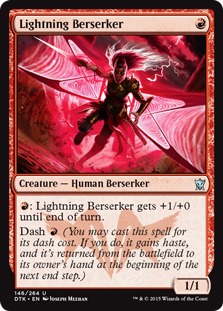
| #Day 1 | #Day2 | Conversion Rate | # 6-4+ | 6-4+ % | #7-3+ | 7-3% | #8-2+ | 8-2% |
| 47 | 31 | 66 | 16 | 34 | 7 | 14.9 | 2 | 4.2 |
The most remarkable thing about Red Aggro's performance at #PTDTK is how unremarkable it actually was. In almost every area, Mono Red is perfectly average, with the only exception being a slightly above average 6-4+ percent. I should probably mention that the Red Aggro heading includes both Mono-Red and Mono-Red splash Green for Atarka's Command. While technically these are two different decks, since they have up to 56 out of the 60 main deck cards in common, it really isn't worth discussing them individually. While most of the pros decided that splashing green was the right move (10 of the 16 decks), including the eventual winner Martin Dang, the decision was far from unanimous, with 6 of the 16 Red Aggro players going straight red. Unfortunately, since Wizards listed both decks together in their metagame breakdown, I couldn't tell you which build performed better even if I wanted to.
One of my biggest questions about Red Aggro heading into the Pro Tour was just how many copies of the legendary Zurgo Bellstriker players would put in their decks. Considering the average was 3.125, the answer appears to be three. Lightning Berserker came in not far behind at 2.875, but the numbers on the firebreather were much more varied. For instance, the winning list only played a single copy, while others played two or three. Atarka's Command, on the other hand, is always a four-of, if you decide to splash green.
Verdict: Despite taking home the trophy, it's hard to classify Red Aggro as either a winner or a loser since the numbers are perfectly average.
Abzan Aggro



| #Day 1 | #Day2 | Conversion Rate | # 6-4+ | 6-4+ % | #7-3+ | 7-3% | #8-2+ | 8-2% |
| 41 | 27 | 65.9 | 13 | 31.7 | 7 | 17 | 3 | 7.3 |
By the numbers, Abzan Aggro is basically Red Aggro minus all the hype and camera time that comes along with a Top 8 finish. Its performance was solid, but unspectacular, coming within a few percentage points of the average.
As far as card choices, there really isn't much that stands out on the whole. Most players ran between one and three Surrak, the Hunt Callers, which is quickly becoming the standard for the archetype. A couple players tried Deathmist Raptor and/or Den Protector, two cards that seemed to be everywhere on day one, but faded down the stretch and missed the Top 8 completely. Dromoka's Command also got some hype (and as we will discuss later, ended up one of the most played DTK cards), with several of the pros saying it was the best card from Dragons of Tarkir and some stating it was good enough to influence their deck selection process.
Verdict: Meh. Another perfectly acceptable but average performance.
Red Green Dragons

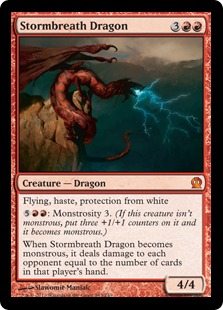

| #Day 1 | #Day2 | Conversion Rate | # 6-4+ | 6-4+ % | #7-3+ | 7-3% | #8-2+ | 8-2% |
| 36 | 21 | 58.3 | 5 | 13.8 | 5 | 13.8 | 1 | 2.7 |
Just when I was getting tired of writing about average performances, G/R Dragons comes along and saves the day! Out of the four decks that made up at least 7.5 percent of the day one field, G/R Dragons was — by far — the worst performing. Not only did it do a poor job of putting its players into day two, but only having five players go 6-4 or better is abysmal.
Despite the deck's failures, Thunderbreak Regent still comes out of #PTDTK a winner, being the most played Dragons of Tarkir rare or mythic with a total of 96 copies among the 6-4+ decks. If you need some copies to build with, consider picking up the Dragons of Tarkir event deck, which at $20 is basically a free-roll since it comes with a Thunderbreak Regent, a Surrak, the Hunt Caller, a couple Roasts, along with some other (somewhat) playable cards. Rattleclaw Mystic was also played way more than I expected, being a four-of in pretty much all the G/R Dragons builds. Unless something like Birds of Paradise shows up in Magic Origins or Lotus Cobra in Battle for Zendikar, I would expect the morph to be worth twice as much this fall once Sylvan Caryatid rotates making Rattleclaw Mystic the best ramper in the format. So if you are planning on playing Temur or any Green-based ramp strategies in the future, I would consider picking up your copies now for $1.50.
Verdict: Loser. A Top 8 is nice, but having 87 percent of your pilots finish worse than 6-4 is just unacceptable.
U/B Control

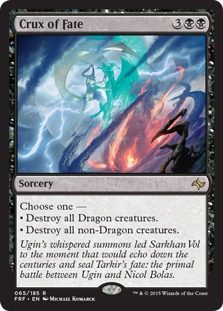
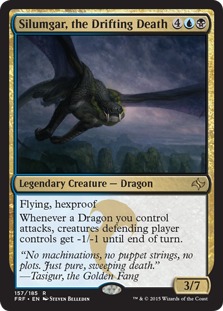
| #Day 1 | #Day2 | Conversion Rate | # 6-4+ | 6-4+ % | #7-3+ | 7-3% | #8-2+ | 8-2% |
| 32 | 29 | 90.6 | 15 | 46.87 | 10 | 31.25 | 7 | 21.88 |
I'm not sure it's possible to overstate just how impressive the performance of U/B Control was at #PTDTK. It's that good. Nine out of ten players on the deck made it into day two, nearly half went 6-4+, and more than one out of five ended up 8-2 or better — not to mention putting three players in the Top 8. These numbers are really off the charts, especially for a deck that made up such a significant percentage (7.8) of the day one field. The deck is so good, you can literally play your cards upside down and still win.
As for individual cards, Dragonlord Silumgar looked good on camera pretty much every time it was cast. In some cases it just won the game on the spot. As a result, the UB elder dragon has increased nearly 30 percent in paper and over 100 percent on Magic Online over the past two days. The ChannelFireball build, while classified as UB, actually splashed white for Dragonlord Ojutai, which was the most played elder dragon at the tournament with 45 copies in the 6-4+ lists. Finally, Icefall Regent was the sneaky dragon at #PTDTK. The Frost Titan/Dungeon Geist hybrid was a centerpiece in Shoota Yasooka's second place brew, and is up to $2 on the back of its Top 8 showing.
Verdict: Epic showing. Very clearly the right choice and the best deck at #PTDTK.
Abzan Control/Mid
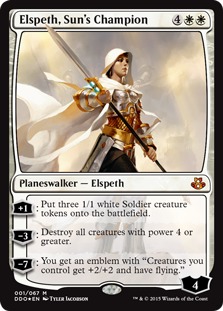


| #Day 1 | #Day2 | Conversion Rate | # 6-4+ | 6-4+ % | #7-3+ | 7-3% | #8-2+ | 8-2% |
| 41 | 31 | 75.4 | 13 | 31.7 | 5 | 12.1 | 2 | 4.8 |
Yawn. For the Magic pros who didn't have the time or resources to build a cool new deck or purchase any Dragons of Tarkir cards, Abzan control was the go-to choice. Personally, I'm sick of watching Siege Rhinos and Elspeth, Sun's Champions bounce off each other, but to each their own. Many of these builds were literally untouched by DTK, like Owen Turtenwald's Abzan deck which only contained Ultimate Price from the set.
As far as the numbers, Abzan Control/Mid was one of the better decks for putting player into day two, but it didn't perform as well in the later stages of the tournament. Maybe this means the deck isn't that good against UB Control which was much more prevalent on day two than on day one? I'm not really sure to be honest. The day two numbers aren't horrible, but considering the above-average conversion rate (which give a deck a better chance of ending up in the 6-4+ bracket), posting only average finishes is a bit disappointing.
Verdict: Winner on day one, loser on day two.
Green/White Devotion



| #Day 1 | #Day2 | Conversion Rate | # 6-4+ | 6-4+ % | #7-3+ | 7-3% | #8-2+ | 8-2% |
| 22 | 10 | 45.5 | 5 | 22.7 | 1 | 4.5 | 1 | 4.5 |
I have to admit that, heading into the Pro Tour, I was secretly wishing for a G/W Devotion mirror in the finals. Untimed rounds, both players at 400 life, best of five, the match would probably still be going. While it is masquerading as a game of Magic, the GW Devotion mirror is actually a test of wills, sort of like those contests where whoever can keeps their hand on the car the longest wins it; you're not actually trying to win, you're just trying to stay awake and keep your bladder from exploding.
Thankfully, the GW Devotion mirror finals wasn't meant to be because G/W Devotion sucked at #PTDTK. Half of its player were done before day two, and only a single player managed to put up seven wins with the deck. It's starting to seem like the deck was a one-hit wonder, being good, and perhaps even great the first time you hear it, but then sending you scrambling for earplugs after a few listens. As such, my hopes for the archetype are not high moving forward. Based on the PT numbers, its not even clear that GW is the best devotion deck any more, as Mono-Green and Green/Red put just as many players in the 6-4+ bracket despite the fact they made up a much smaller percentage of the field. Even worse, Sam Black, who only a month ago thought he had the best deck in the room when his build of GW Devotion made its debut, decided he would rather be Roasting his own Hornet Nest than manifesting with Mastery of the Unseen. Not exactly a vote of confidence for the archetype.
Verdict: Stick a fork in it.
Jeskai Aggro/Jeskai Tokens



Jeskai Aggro
| #Day 1 | #Day2 | Conversion Rate | # 6-4+ | 6-4+ % | #7-3+ | 7-3% | #8-2+ | 8-2% |
| 26 | 16 | 61.5 | 6 | 23 | 1 | 3.8 | 0 | 0 |
Jeskai Tokens
| #Day 1 | #Day2 | Conversion Rate | # 6-4+ | 6-4+ % | #7-3+ | 7-3% | #8-2+ | 8-2% |
| 21 | 9 | 42.9 | 4 | 19 | 1 | 4.7 | 0 | 0 |
I thought it might be fun to discuss these two decks together and try to determine once and for all which Jeskai build is best. Unfortunately, both performed so poorly that it's really hard to make a definitive statement. By the numbers, token builds of Jeskai were awful by pretty much every measure. The deck didn't put players into day two, didn't give players 6-4+ records, and didn't manage any premiere finishes. Jeskai Aggro actually performed better, although still below average, and its number are boosted a bit by the relatively strong performance of a few Jeskai Dragons decks which got lumped in.
this poor showing is surprising; it wasn't that long ago that Jeskai was clearly the best clan in Standard, and it seemed to only get better with new additions from Fate Reforged. Now, barely two month later, its performance at #PTDTK has me questioning whether it is really playable at all. If you do decide on playing Jeskai in the coming weeks, your best bet is to move forward on the Thunderbreak Regent/Stormbreath Dragon/Dragonlord Ojutai plan, rather than the Raise the Alarm/Hordeling Outburst/Jeskai Ascendancy plan, although it might be better to just play something else altogether if you have the option.
Verdict: Losers.
Sidisi Whip
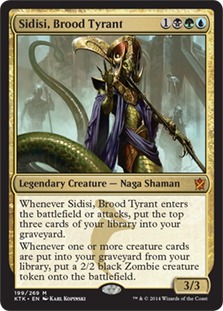


| #Day 1 | #Day2 | Conversion Rate | # 6-4+ | 6-4+ % | #7-3+ | 7-3% | #8-2+ | 8-2% |
| 19 | 16 | 84.2 | 4 | 21 | 1 | 5.2 | 0 | 0 |
Sidisi Whip has the strangest numbers. It posted the second best conversion rate (behind UB Control) out of the 10 most played decks at the event, but then it fell off a cliff in day two, putting only four of its 19 players in the 6-4+ bracket. I guess this goes to show how at big, multi-day events, early success doesn't necessarily translate to the day two meta or a strong finish. Since most of these lists are fairly stock and predictable, I'd like to take a minute to highlight Willy Edel's awesome looking Den Protector/Dragonlord Atarka/Deathmist Raptor build.

Quick Notes on Other Decks
Since the field at #PTDTK was far too diverse to do an in depth write up on every single deck, here are some quick hitters regarding decks that made up less than 4 percent of the day one field.
- Five players, including Reid Duke were on the Chromanticore/Soulflayer deck. All of these players made day two, but none managed to hit the 6-4 mark. This might matter financially, since a casual player who didn't follow the live coverage but browses through the lists isn't going to find the brew.
- U/W Heroic had the worst conversion rate, only putting 36 percent of its players into day two.
- Two players tried to play Rally the Ancestors combo. Neither made day two.
- Sam Black and company brought G/R Bees to battle. Apparently the deck kills aggro. Unfortunately UB Control was the best deck at the event.
- Four Abzan players were splashing Dragonlord Atarka. All of them made day two including Seth Mansfield who lost two win-and-ins for Top 8.
Dragons of Tarkir at #PTDTK
Last week I found myself questioning just how much impact Dragons of Tarkir would have on the Pro Tour. Since Pro Tours after rotationsare generally most influenced by new cards, I wasn't super hopeful, but all in all, DTK did quite well for itself. Here's a list of all the DTK cards that appeared in decks with records of 6-4 or better.
| Card | Num Copies |
|---|---|
| Ultimate Price | 119 |
| Roast | 102 |
| Thunderbreak Regent | 96 |
| Dromoka's Command | 85 |
| Anticipate | 78 |
| Dragon Fodder | 61 |
| Negate | 56 |
| Draconic Roar | 54 |
| Zurgo Bellstriker | 50 |
| Deathmist Raptor | 49 |
| Duress | 49 |
| Lightning Berserker | 46 |
| Dragonlord Ojutai | 45 |
| Haven of the Spirit Dragon | 45 |
| Atarka's Command | 44 |
| Dragonlord Atarka | 42 |
| Silumgar's Scorn | 40 |
| Den Protector | 33 |
| Surrak, the Hunt Caller | 31 |
| Foul-Tongue Invocation | 29 |
| Seismic Rupture | 27 |
| Dragonlord Silumgar | 21 |
| Encase in Ice | 19 |
| Dragonlord's Prerogative | 18 |
| Secure the Wastes | 17 |
| Sidisi, Undead Vizier | 15 |
| Virulent Plague | 13 |
| Icefall Regent | 12 |
| Self-Inflicted Wound | 10 |
| Twin Bolt | 9 |
| Narset Transcendent | 8 |
| Shaman of Forgotten Ways | 8 |
| Stratus Dancer | 8 |
| Ojutai Exemplars | 6 |
| Display of Dominance | 6 |
| Avatar of the Resolute | 6 |
| Rending Volley | 6 |
| Ojutai's Command | 5 |
| Dragonlord Dromoka | 5 |
| Kolaghan's Command | 5 |
| Surge of Righteousness | 5 |
| Dragon Whisperer | 4 |
| Hidden Dragonslayer | 4 |
| Collected Company | 4 |
| Ainok Survivalist | 3 |
| Magmatic Chasm | 3 |
| Myth Realized | 2 |
| Radiant Purge | 2 |
| Hedonist's Trove | 1 |
| Sarkhan Unbroken | 1 |
| Risen Executioner | 1 |
| Profaner of the Dead | 1 |
| Learn from the Past | 1 |
| Evolving Wilds | 1 |


The biggest disappointment on this list are the two new planeswalkers: Narset Transcendent and Sarkhan Unbroken. I assumed that if anyone could figure out how to put these two powerful but unplayed cards to good use, it would be 409 pros with weeks to prepare. Instead, we ended up with 8 copies of Narset Transcendent and only one copy of Sarkhan Unbroken. Since the Pro Tour generally sets the metagame for the foreseeable future, it seems unlikely that these cards will break out anytime soon. As a result, their prices will almost inevitably decline. If you haven't got your copies yet, hold on for another month or two, wait for DTK redemption to start, and for the focus of the Magic world to shift to Modern Masters 2015. Barring some crazy innovation at the GP/SCG level, I would bet that you'll be able to pick up Sarkhan Unbroken for close to $10 and Narset Transcendent for $15 or $20 this summer.
On the other hand, Haven of the Spirit Dragon seems like the real deal. I know you might not take my opinion on dragon lands that seriously given my history with Crucible of the Spirit Dragon, but Haven of the Spirit Dragon actually has potential to be a Standard staple from an under-opened large, spring set (not to mention its obvious casual appeal). Remember Mutavault, and how omnipresent it was a year ago? That's because most decks, even two or three color decks, can afford to give up some number of land slots to a colorless land without hurting their mana in a meaningful way. Apart from Radiant Fountain, Haven of the Spirit Dragon has basically no competition for this slot. If you are a two-color deck running a play set of Stormbreath Dragon, the opportunity cost of running a copy or two of Haven is almost non-existent. Plus, getting back Ugin, the Spirit Dragon is a pretty big deal — we saw a player at #PTDTK -7 his own Ugin, the Spirit Dragon (when a -4 would have swept the board) just so he could get the planeswalker to the graveyard and back to his hand with Haven of the Spirit Dragon. While the other big winners, Dragonlord Atarka, Dragonlord Silumgar, and Den Protector, have already increased in price, the dragon-land hasn't, but based on this weekend and the number of dragons in Standard, it should, and possible soon.
Conclusion
Anyway, that's all for today. What do you make of these numbers? What DTK card surprised you the most at the Pro Tour? Apart from the invisible planeswalkers, what was most disappointing? How does the Pro Tour metagame impact your deck choices moving forward? As always, leave your thoughts and opinions in the comments, or you can reach me on Twitter @SaffronOlive.













